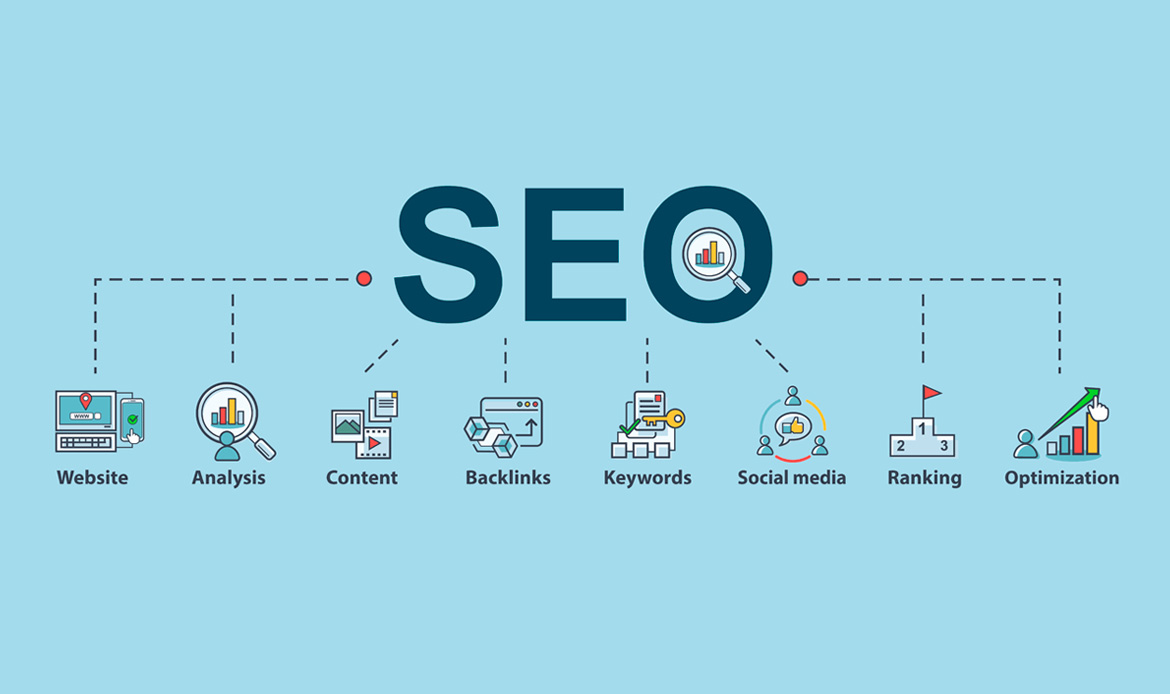Maximize your digital marketing impact with our comprehensive guide on SEO in digital marketing. Discover actionable insights and expert strategies to optimize your online content, boost search engine rankings, and achieve long-term success in the digital realm.
In an era where the digital landscape is continually evolving, establishing a robust online presence has become integral to the success of any business or brand. As consumers increasingly turn to search engines to discover products, services, and information, understanding and harnessing the Power of SEO in Digital Marketing has never been more critical.
This comprehensive guide serves as your roadmap through the intricacies of Search Engine Optimization (SEO), unveiling the strategies and techniques that can propel your digital endeavors to new heights.
From unraveling the mysteries of search engine algorithms to implementing effective optimization practices, join us on a journey that demystifies the complexities of SEO, empowering you to not only navigate but dominate the ever-competitive digital landscape.
Whether you’re a seasoned marketer or a business owner looking to enhance your online visibility, this guide is your go-to resource for unlocking the true potential of SEO in the dynamic realm of digital marketing. Get ready to elevate your online presence, drive organic traffic, and position yourself for sustained success.
1: Understanding SEO

Mobile marketing operates through various channels and strategies to engage with users on their mobile devices. Here’s a breakdown of how mobile marketing works:
1.1 What is SEO?
SEO, or Search Engine Optimization, is a set of strategies and techniques designed to improve a website’s visibility on search engines like Google, Bing, and Yahoo. The goal is to increase organic (non-paid) traffic to a website by optimizing various elements, both on and off the site, to rank higher in search engine results pages (SERPs).
1.2 How Search Engines Work
A fundamental understanding of search engine algorithms is crucial to grasp the importance of SEO. Search engines use complex algorithms to evaluate and rank websites based on various factors, including relevance, authority, and user experience. SEO helps businesses align their online presence with these algorithms to improve their search rankings.
2: The Components of SEO

2.1 On-Page SEO
On-page SEO involves optimizing the content and HTML source code of a webpage. This includes keyword optimization, meta tags, header tags, URL structure, and multimedia elements. Creating high-quality, relevant content that addresses user intent is a cornerstone of on-page SEO.
2.2 Off-Page SEO
Off-page SEO focuses on building a website’s authority and credibility through external factors. This includes backlink building, social media engagement, influencer collaborations, and online mentions. Off-page SEO signals tell search engines that a website is trustworthy and valuable.
2.3 Technical SEO
Technical SEO deals with the technical aspects of a website, ensuring that it is easily accessible and understandable by search engines. This includes optimizing site speed, mobile responsiveness, and fixing crawl errors. A technically sound website contributes to better user experience and higher search rankings.
3: The Significance of SEO in Digital Marketing

3.1 Increased Visibility and Traffic
The primary goal of SEO is to improve a website’s visibility in search results. By optimizing for relevant keywords and providing valuable content, businesses can attract more organic traffic, reaching users actively searching for products or services.
3.2 Credibility and Trust
Websites that appear at the top of search results are often perceived as more credible and trustworthy by users. SEO helps businesses build a positive online reputation, fostering trust among their target audience.
3.3 Cost-Effectiveness
Compared to paid advertising, SEO is a cost-effective long-term strategy. While it may take time to see results, the sustained organic traffic generated by SEO efforts can provide a high return on investment (ROI) over time.
3.4 Insightful Analytics
SEO tools provide valuable insights into user behavior, keyword performance, and other critical metrics. These analytics help businesses make informed decisions, refine their strategies, and adapt to changing trends.
4. SEO Best Practices

4.1 Keyword Research
Keyword research is the foundation of SEO. Identifying and targeting relevant keywords that align with user intent ensures that your content is discoverable by the right audience.
4.2 Content Quality and Relevance
Creating high-quality, relevant content is crucial for SEO success. Content should address user queries, provide valuable information, and engage the audience. Regularly updating and expanding content keeps the website fresh and signals its relevance to search engines.
4.3 Link Building
Backlinks, or links from other reputable websites to yours, are a key ranking factor. However, quality is more important than quantity. Building a diverse, natural link profile through outreach, collaborations, and content marketing is essential.
4.4 Mobile Optimization
As more users access the internet on mobile devices, optimizing your website for mobile is imperative. Search engines prioritize mobile-friendly websites, and a positive mobile experience enhances user satisfaction.
4.5 User Experience
User experience (UX) is a crucial aspect of SEO. A well-designed, easy-to-navigate website with fast loading times contributes to a positive user experience, which in turn positively impacts search rankings.
5: Adapting to Algorithm Changes
Search engines regularly update their algorithms to provide users with the most relevant and high-quality results. Staying informed about these changes and adapting your SEO strategies accordingly is essential for long-term success. Following reputable SEO blogs, participating in industry forums, and engaging in continuous learning are key aspects of staying ahead in the ever-evolving world of SEO.
6: Local SEO

6.1 Local Search Importance
For businesses targeting a local audience, local SEO is paramount. Optimizing for local search involves strategies like creating and optimizing Google My Business listings, obtaining local citations, and garnering positive reviews. This helps businesses appear in local search results, making them easily discoverable by nearby customers.
6.2 NAP Consistency
Name, Address, and Phone Number (NAP) consistency is crucial for local SEO. Ensuring that your business information is consistent across all online platforms and directories builds trust with search engines and enhances your local search visibility.
7. SEO and Content Marketing Synergy

7.1 Content as the Foundation
SEO and content marketing are intricately connected. Content marketing, producing and distributing valuable content, supports SEO efforts by providing the material search engines seek to index. The two work synergistically to enhance online visibility, drive traffic, and establish authority.
7.2 Blogging for SEO
Maintaining a blog is an effective content marketing strategy that complements SEO efforts. Regularly publishing blog posts allows businesses to target specific keywords, answer user queries, and keep their website content fresh—a factor search engines favor.
8: International SEO

8.1 Expanding Global Reach
For businesses with an international audience, international SEO is vital. This involves tailoring your website and content to different languages and regions, optimizing for local search engines, and considering cultural nuances in your online strategy.
8.2 Hreflang Tag Implementation
The hreflang tag is a critical element for international SEO. It helps search engines understand which language versions of a page to display for users in different locations, avoiding duplicate content issues and ensuring a seamless user experience.
9: SEO Tools and Analytics

9.1 Google Analytics
Google Analytics is an essential tool for tracking website performance, user behavior, and the effectiveness of SEO strategies. It provides valuable insights that help businesses make data-driven decisions and refine their digital marketing efforts.
9.2 SEO Platforms
There are numerous SEO tools and platforms that aid in keyword research, competitor analysis, backlink monitoring, and more. Examples include Ahrefs, SEMrush, Moz, and Yoast SEO for WordPress. Utilizing these tools can streamline and enhance your SEO efforts.
10: Future Trends in SEO
10.1 Voice Search Optimization
With the increasing prevalence of voice-activated devices, optimizing for voice search is becoming crucial. Businesses need to understand how users phrase voice queries and tailor their content to align with natural language patterns.
10.2 Artificial Intelligence (AI) and SEO
AI is playing an increasingly significant role in SEO. Search engines use AI algorithms to understand user intent, deliver personalized search results, and adapt to changing trends. Businesses need to embrace AI tools and technologies to stay competitive in the evolving landscape.
11: Social Media and SEO Integration
11.1 Social Signals
While social media platforms themselves don’t directly impact search rankings, social signals such as likes, shares, and comments can indirectly influence SEO. Engaging content that resonates on social media can generate backlinks and drive traffic, positively impacting search visibility.
11.2 Social Media Profiles in Search Results
Search engines often display social media profiles in their results for branded searches. Optimizing social media profiles with accurate information, engaging content, and links to the website contributes to a comprehensive online presence.
12: User-Generated Content and Reviews

12.1 Building Trust through User-Generated Content
User-generated content (UGC), such as reviews, testimonials, and customer-generated media, can enhance trust and credibility. Positive reviews not only influence potential customers but also contribute to search engine algorithms, reinforcing a website’s authority.
12.2 Responding to Reviews
Active engagement with user-generated content, especially reviews, is crucial. Responding to reviews, both positive and negative, demonstrates a commitment to customer satisfaction. It also provides an opportunity to address concerns publicly, showing transparency and accountability.
13: SEO for E-commerce
13.1 Product Page Optimization
For e-commerce websites, optimizing product pages is essential. This involves using descriptive product titles, creating unique product descriptions, optimizing images, and implementing structured data markup to enhance visibility in search results.
13.2 E-commerce SEO Challenges
E-commerce sites often face challenges such as duplicate content, thin product descriptions, and complex site structures. Overcoming these challenges through strategic SEO solutions is vital for e-commerce success.
14: SEO and Branding
14.1 Building a Strong Brand Presence
SEO and branding are interconnected; a strong brand presence can positively impact search rankings. Consistent branding across all online channels, including a well-optimized website, contributes to brand authority in the eyes of search engines.
14.2 Brand Mentions and Citations
Search engines consider brand mentions and citations as signals of authority. Building a brand presence beyond the website, including mentions in press releases, industry publications, and reputable websites, contributes to a robust SEO strategy.
15: Measuring SEO Success
15.1 Key Performance Indicators (KPIs)
Measuring the success of your SEO efforts involves tracking key performance indicators. Common KPIs include organic traffic, keyword rankings, conversion rates, and user engagement. Regularly monitoring these metrics provides insights into the effectiveness of your strategy.
15.2 Return on Investment (ROI)
Calculating the return on investment from SEO efforts is essential for demonstrating the value of your digital marketing efforts. Understanding the financial impact of improved search rankings and increased organic traffic helps justify ongoing SEO investments.
Epilogue: The Ever-Evolving Journey of SEO

In the fast-paced realm of digital marketing, the journey with SEO is perpetual. The landscape continually evolves as search engines refine their algorithms, user behavior changes, and new technologies emerge. To sustain and enhance the power of SEO, businesses must adopt a mindset of continuous improvement and adaptation.
Algorithmic Changes:
Staying informed about search engine algorithm updates is paramount. Google, for instance, regularly releases updates that can significantly impact search rankings. Adapting to these changes ensures that your SEO strategies align with current best practices.
Voice Search and AI:
The rise of voice-activated devices and artificial intelligence presents new challenges and opportunities. Optimizing for voice search and leveraging AI tools can keep businesses ahead of the curve, aligning their strategies with emerging technologies.
User Intent:
Search engines increasingly prioritize understanding and satisfying user intent. Crafting content that precisely addresses user queries, aligns with search intent, and provides genuine value remains central to SEO success.
Mobile-First Indexing:
The shift towards mobile-first indexing means that search engines prioritize the mobile version of a website for ranking and indexing. Ensuring mobile responsiveness and a seamless user experience on various devices is non-negotiable.
Local and Global Considerations:
Tailoring SEO strategies to the local or global nature of a business is crucial. Local SEO tactics, such as optimizing for “near me” searches, are vital for brick-and-mortar establishments, while international SEO considerations become pivotal for businesses with a global audience.
Social Media Integration:
Recognizing the interconnectedness of social media and SEO is imperative. While social signals may not be direct ranking factors, a robust social media presence positively influences brand visibility, user engagement, and indirectly impacts search rankings.
User Experience and Core Web Vitals:
User experience is an evergreen priority for search engines. Core Web Vitals, a set of metrics that assess page loading speed, interactivity, and visual stability, have gained prominence. Websites that offer a superior user experience are likely to be favored by search algorithms.
Data Privacy and Security:
With an increasing focus on user privacy, search engines may prioritize secure websites (those with HTTPS) and penalize those that don’t adhere to data protection standards. Prioritizing data privacy and security is not only ethical but aligns with SEO best practices.
In the dynamic world of SEO, the journey is both challenging and rewarding. By embracing change, staying informed, and aligning strategies with user needs and search engine expectations, businesses can navigate the evolving landscape with confidence.
Frequently Asked Questions
Q1: What is SEO, and why is it important in digital marketing?
SEO, or Search Engine Optimization, is a set of strategies aimed at improving a website’s visibility on search engines. It is crucial in digital marketing because it helps businesses attract organic (non-paid) traffic, enhances online credibility, and ensures that their content is easily discoverable by users actively searching for products or services.
Q2: What are the key components of SEO?
The key components of SEO include on-page optimization (content, meta tags, URL structure), off-page optimization (backlink building, social signals), and technical optimization (site speed, mobile responsiveness). Each component plays a crucial role in improving a website’s search rankings.
Q3: How does SEO contribute to the success of digital marketing?
SEO contributes to the success of digital marketing campaigns by increasing online visibility, attracting targeted organic traffic, and building credibility. It is a cost-effective strategy with long-term benefits, providing valuable insights through analytics that can inform and refine broader digital marketing efforts.
Q4: How does mobile optimization impact SEO, and why is it important?
Mobile optimization is crucial for SEO because search engines prioritize mobile-friendly websites. With the increasing use of mobile devices, ensuring a positive user experience on smartphones and tablets contributes to higher search rankings and satisfies user expectations.
Q5: How can businesses measure the success of their SEO efforts?
Businesses can measure SEO success through key performance indicators (KPIs) such as organic traffic, keyword rankings, conversion rates, and user engagement. Additionally, calculating the return on investment (ROI) from SEO efforts provides insights into the financial impact of improved search rankings.
Conclusion
In conclusion, the Power of SEO in Digital Marketing is an indispensable force that can shape the trajectory of your online success. As we’ve journeyed through this comprehensive guide, you’ve gained insights into the intricacies of Search Engine Optimization, understanding its pivotal role in enhancing online visibility, attracting organic traffic, and ultimately driving business growth.
By unraveling the complexities of search engine algorithms, mastering the art of keyword optimization, and embracing content strategies that resonate with both algorithms and human audiences, you’ve equipped yourself with the tools to not only survive but thrive in the dynamic digital landscape.
Remember, the world of SEO is ever-evolving, and staying ahead requires continuous learning and adaptation. Regularly revisit and refine your SEO strategy to align with industry trends and algorithm updates. Consistency is key, and the impact of strategic SEO implementation often unfolds over time, solidifying your position as a credible and authoritative presence in your niche.
As you embark on applying the principles outlined in this guide, envision your digital presence as a dynamic entity that evolves and adapts, just as the digital landscape itself does. With the Power of SEO in your arsenal, you’re well-positioned to not only meet the challenges of the digital era but to lead and innovate in a way that sets you apart.
Here’s to your continued success in the ever-expanding realm of digital marketing, armed with the knowledge and strategies to harness the true power of SEO.


